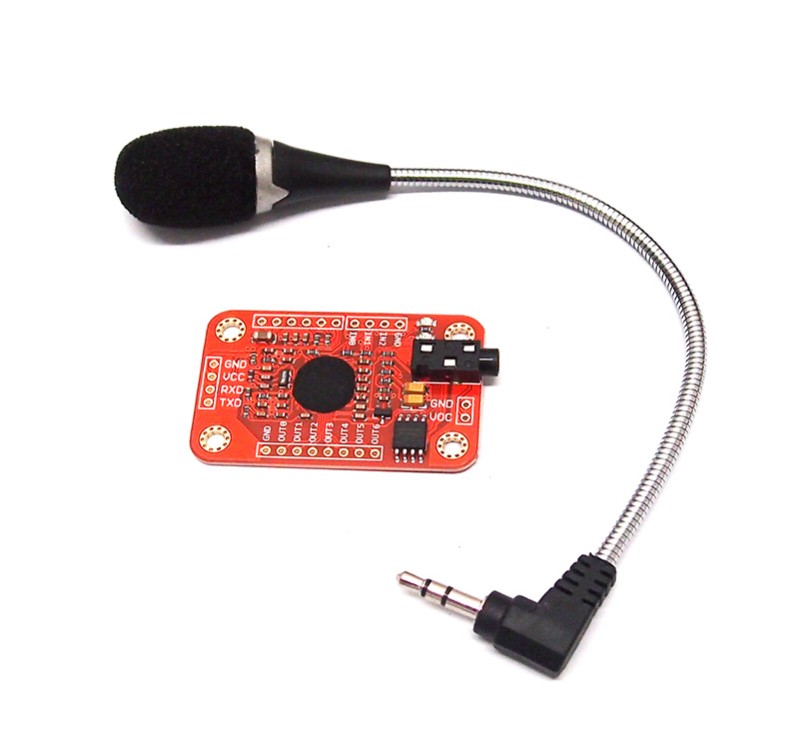





VOICE RECOGNITION MODULE
Voice recognition is a deep learning technique used to identify, distinguish, and authenticate a particular person's voice. It evaluates an individual's unique voice biometrics, including frequency and flow of pitch, and natural accent.
₹ 2,075 ₹2,834
2,834



| Made In : | India |
Add FAQ
Voice recognition technology enables devices to understand and respond to human speech. It's widely used in applications ranging from virtual assistants and automated customer service systems to hands-free controls and accessibility tools. Here’s a comprehensive overview of voice recognition technology, including its principles, applications, and integration with microcontrollers like Arduino.
Key Features:
-
Voice Recognition Principles:
- Acoustic Model: Uses machine learning algorithms to interpret sound waves and identify phonemes (distinct units of sound) in speech.
- Language Model: Applies statistical methods to predict and understand words and phrases based on context.
- Speech-to-Text (STT): Converts spoken words into written text, allowing systems to process and respond to user commands.
-
Components:
- Microphone: Captures audio input from the user.
- Signal Processing: Filters and processes audio signals to improve clarity and remove noise.
- Feature Extraction: Converts audio signals into features that can be analyzed by the recognition algorithms.
- Recognition Engine: Analyzes features and matches them to stored patterns to recognize words and commands.
-
Types of Voice Recognition:
- Speaker-Dependent: Trained to recognize the voice of a specific user, providing personalized responses.
- Speaker-Independent: Designed to recognize voices from any user, suitable for general applications.
Applications:
-
Virtual Assistants:
- Examples: Amazon Alexa, Google Assistant, Apple Siri.
- Function: Provide information, perform tasks, and control smart devices using voice commands.
-
Voice-Activated Controls:
- Examples: Voice-controlled home automation systems, hands-free devices.
- Function: Allow users to control devices and systems through voice commands.
-
Accessibility:
- Examples: Voice-to-text for individuals with disabilities, voice-controlled wheelchairs.
- Function: Enable users with physical or visual impairments to interact with technology.
-
Customer Service:
- Examples: Automated phone systems, chatbots.
- Function: Provide customer support and handle routine inquiries through voice commands.
Integrating Voice Recognition with Microcontrollers:
Microcontrollers like Arduino can interface with voice recognition modules to add voice control capabilities to projects. Here’s an example using a popular voice recognition module, the Elechouse Voice Recognition Module V3:
Wiring Instructions:
- Voice Recognition Module to Arduino:
- VCC (Voice Module) to 5V (Arduino).
- GND (Voice Module) to GND (Arduino).
- TX (Voice Module) to RX (Arduino) (e.g., D2 if using SoftwareSerial).
- RX (Voice Module) to TX (Arduino) (e.g., D3 if using SoftwareSerial).

#include <SoftwareSerial.h> // Include the SoftwareSerial library for communication with the Voice Recognition Module
// Create a software serial port to communicate with the Voice Recognition Module
SoftwareSerial voiceSerial(10, 11); // RX, TX pins connected to the Voice Recognition Module
// Define variables to store voice command numbers
int voiceCommand = -1; // Variable to store the recognized command
void setup() {
// Start serial communication for debugging (to see output on the Serial Monitor)
Serial.begin(9600);
// Start communication with the Voice Recognition Module
voiceSerial.begin(9600); // Default baud rate for the Voice Recognition Module
// Print initial message to Serial Monitor
Serial.println("Voice Recognition Module - Listening for commands...");
}
void loop() {
// Check if data is available from the Voice Recognition Module
if (voiceSerial.available() > 0) {
voiceCommand = voiceSerial.read(); // Read the voice command ID from the module
// Print the recognized voice command to Serial Monitor
Serial.print("Voice Command ID: ");
Serial.println(voiceCommand);
// Perform actions based on the recognized command
if (voiceCommand == 1) {
// Command ID 1 corresponds to the first command (e.g., "Turn On")
Serial.println("Command 'Turn On' recognized! Performing action...");
// Add any action you want to perform for this command (e.g., turning on a light)
digitalWrite(13, HIGH); // Example action: Turn ON LED on pin 13
}
else if (voiceCommand == 2) {
// Command ID 2 corresponds to the second command (e.g., "Turn Off")
Serial.println("Command 'Turn Off' recognized! Performing action...");
// Add any action you want to perform for this command (e.g., turning off a light)
digitalWrite(13, LOW); // Example action: Turn OFF LED on pin 13
}
else {
// Handle other commands here
Serial.println("Unknown command!");
}
}
}
0 Reviews For this Product












.jpg&width=225&quality=80)
